Archive for the 'Conservation' Category
Waste Water Resort
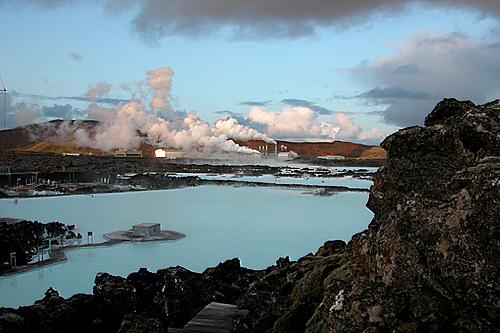
Photo Credit: inigo.txg
In Iceland, there is a well known Resort and Spa called the Blue Lagoon which owes its existence to Hitaveita Suðurnesja, who drilled for the geothermal fluid found in the region. The wells are as deep as 2,000 meters (~6,500′) and the extracted fluid attains a temperature of 243°C (~470°F.)
This geothermal fluid is then used to heat freshwater for central heating purposes and to produce electricity. The power plant provides about 17,000 people with hot water for central heating and about 45,000 people electricity.
The geothermal fluid, now a cooler temperature and essentially “waste water,” is piped directly to the Blue Lagoon where people enjoy relaxing in the warm aquamarine lagoon and benefit from its unique active ingredients: minerals, silica and blue green algae. The lagoon holds approximately six million liters of geothermal waste water at around 40°C (104°F.) The lagoon water supply is completely refreshed every 40 hours. Visitors from all over the world come to the Blue Lagoon for the waters positive effect on the skin, they bath, have mud treatments, and every other spa/resort type activity you can think of.
The combination of the power plant, the heating system, and the resort make very good use of the geothermal resource – who would have guessed that the waste product could not only be valuable, but is also beautiful.
Links:
Blue Lagoon Resort
Comments are off for this post
DIY Solar Hot Water Heater
In the spirit of Earth Day, here’s a little project virtually anyone can attempt, if you’ve got any solar resource at all. Most homes spend around 30% of their energy budget heating water. Get 100 meters of black hose, a few connectors, and a place to site your heater and you’re in business with a cost effective solar hot water heater.
With the humor out of the way, here’s the rest of the story…
Hats off to Green Power Science who put these entertaining, yet cheesy, videos together.
1 comment
The Smarter Plug
When we started looking at business opportunities in the clean tech space, one of our original concepts was that of the “smart plug.” Given the heavy tech background of the team, a tech device made a huge amount of sense. We obviously decided to go another way, however, we still believe the idea has merit. That’s where Green Plug comes in.
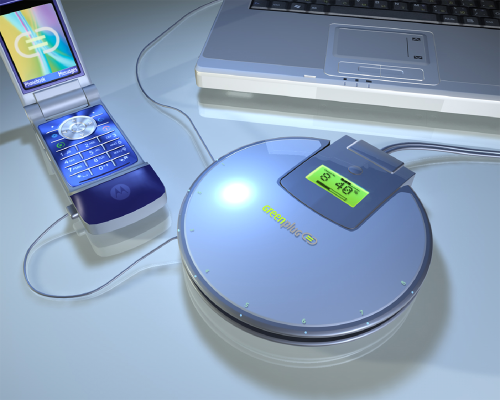
Image Credit: Green Plug
Green Plug has taken the approach of creating a small bit of silicon enabled by smart software to allow for the efficient charging of any DC device from their hub. When the device charge is complete, the power to that charging port is terminated. The net is, it delivers just the right amount of juice to the right device a the right time and not a watt more.
Ultimately, we didn’t choose to pursue a similar idea as we believed it would take substantial government regulation to force device manufacturers to include such silicon and software in their products. While we still hold this view, it’s great to see that Green Plug has provided a viable alternative and as the regulators step up to the challenge there won’t be technology lag. In the meantime, we do believe Green Plug will have an uphill climb, good luck!
Comments are off for this post
Tips for Fuel Efficiency
As the price at the pump continues to rise, the transportation segment looks for more ways to reduce cost of fuel. It is possible that there are a few very simple things we can do that will reduce our gasoline consumption by as much as 10%. Most are simple, most are common sense, and most are very inexpensive. Here are some simple ideas to increase fuel efficiency:
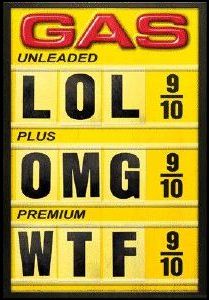
- Remove Unnecessary Mass – Each reduction of 45kg (100lbs) will increase fuel efficiency as much as 2%. One of our partners observes “Another good reason to diet.”
- Proper Tire Inflation – This simple item can increase fuel efficiency as much as 3%. Even if you must pay for air, you’ll get a return on your investment.
- Tune Up – Having the right grade and fresh motor oil along with a clean air filter can increase fuel efficiency as much as 5%.
- Drive Sensibly – Interestingly, the thing that is right in our control is the thing that we least frequently do. Drive the speed limit, avoid hot rod starts and stops, and try to use your brakes as little as possible. Depending on your driving technique, this can yield 5-33% better fuel economy.
- Combine Trips – This pre-planning makes it possible to reduce overall driving and fuel demand.
- Don’t Idle – Any stop longer than a traffic light and you should consider switching your engine off; idling simply burns fuel with no forward momentum.
- Alter the Commute – There are several ways to do this including biking to work, taking public transit, telecommuting, and even shifting your work schedule to spend less time simply sitting in traffic.
Try some or all of the techniques above and see how your fuel efficiency changes. Most importantly though, measure your consumption. Before you change anything, establish a baseline consumption level, once that is calculated, make one change and observe the result. Then make the next change and observe the result. In this way, you can make a 10% difference and know which items have the most impact in your situation.
Thanks for dropping by, you can also save money by replacing your old incandescent bulbs with compact fluorescent. We’ve got real data on electricity consumption before and after switching out the 83 of 95 bulbs in one home. Think it’s pennies? You’d be surprised, we’re on track for a $4,100 savings – $600 better than our initial projections.
Real Data on CFL Replacement
People are making all sorts of claims about energy efficient lighting, and we’re on that bandwagon too. Having systematically inventoried, evaluated, and replaced incandescent lighting with compact fluorescent lamps in June, 2007. In fact, one of the most popular entries ever to appear in this journal was titled “Want to get $3,500?” which talks about the inventory, method, and expected savings of replacing standard lighting with energy efficient lighting. With seven months of data available, I thought it was time to check expectations with reality.
Here are the headlines:
- Total kwH saved: 920
- Total $ saved (electricity bill): $299.18
- Total lightbulb burnout replacement $ avoided: $42.00
- Equivalent tree impact: 48 trees planted
In seven months, we’ve recovered the “real $” investment in replacement lamps just with the savings in the monthly utility bill and lack of bulb replacement from burn outs. It was a great theory in June, it’s even better seeing it in reality in February. The chart below shows the actual electricity consumption change over time. We’ve got data from January of 2006 (so a full year of incandescent bulbs) and the first 6 months of 2007. The bulbs were replaced in the third week of June, 2007.
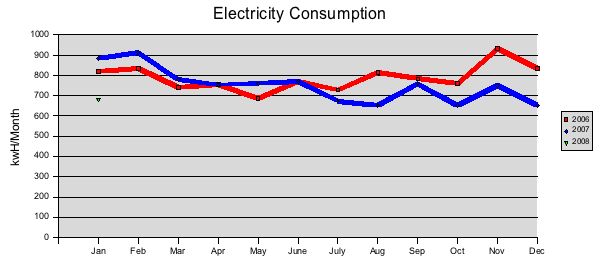
Now kwH reduction is interesting, but absolute cost reduction is king. Sure, we all want to to things that help the planet, but when you can combine that with a real measurable economic impact, that’s even better! The actual electricity charges are listed below for the same time period. One might notice that September was a funky month, it’s due to a large-scale data storage test that was conducted in this location and it almost accounted for the entire months savings. It’s easy to affect these numbers with activities like that.
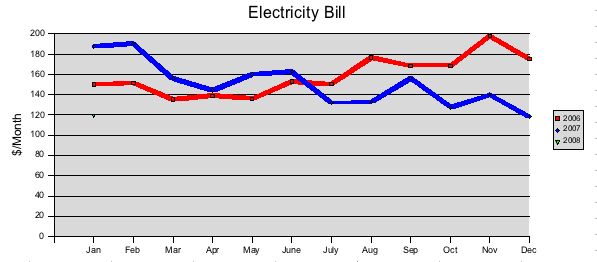
One important thing to note about the cost savings on the monthly electrical bill, PG&E penalizes consumers rather stiffly for what it considers to be excessive use of power. Meaning the rates graduate from the base consumption of around $0.11/kwH to $0.32/kwH as the top tier rate. The lighting change is displacing kwH charged at the higher rate in our case, so if you choose to do this, make sure you understand how much you’re paying per kwH because it will affect your results.
Three other items of note: before the CFL bulbs, we were replacing about 1.5 incandescent lightbulbs per month (~$4 cost for the bulbs that would blow) – we’ve had zero replacements thus far in the CFL era. We haven’t had a break or replace situation, so cleanup and recycling hasn’t become an issue yet, this is still harder than it needs to be as we’ve had to dig to find places that will accept these bulbs post-use. It’s important to handle them properly as there is a small amount of mercury in the bulbs (with over 80 installed, it’s still far less than the amount of mercury in old of the old, small thermometers to put the risk in perspective.)
Finally, we have had one adjustment with respect to lighting, the 20 second or so “warm up” period. When the bulb is switched on, it goes to about 70% of illumination. Within 20 seconds, it’s up to 100%. At first, this is a little disconcerting, but it’s not noticed any more. The quality of the light is equivalent or better than the incandescent bulbs – it’s warm and full spectrum (choose your CFL’s carefully, we prefer the Philips brand for light quality and warmth.)
Convinced to make the switch yet? If you do, please leave a comment to let us know how it went. More data is better.
1 comment








